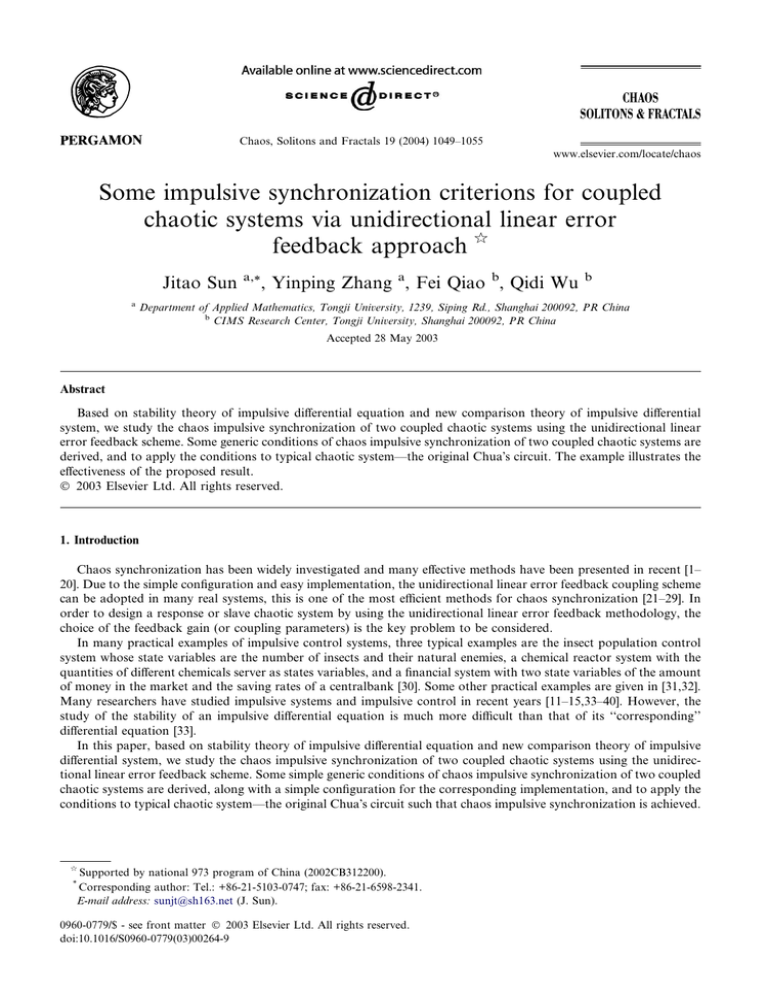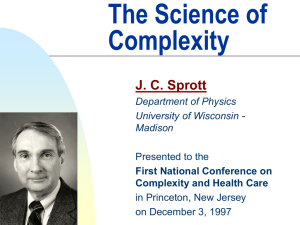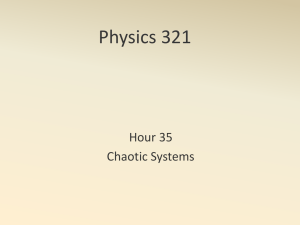
Chaos, Solitons and Fractals 19 (2004) 1049–1055
www.elsevier.com/locate/chaos
Some impulsive synchronization criterions for coupled
chaotic systems via unidirectional linear error
feedback approach q
Jitao Sun
a
a,*
, Yinping Zhang a, Fei Qiao b, Qidi Wu
b
Department of Applied Mathematics, Tongji University, 1239, Siping Rd., Shanghai 200092, PR China
b
CIMS Research Center, Tongji University, Shanghai 200092, PR China
Accepted 28 May 2003
Abstract
Based on stability theory of impulsive differential equation and new comparison theory of impulsive differential
system, we study the chaos impulsive synchronization of two coupled chaotic systems using the unidirectional linear
error feedback scheme. Some generic conditions of chaos impulsive synchronization of two coupled chaotic systems are
derived, and to apply the conditions to typical chaotic system––the original ChuaÕs circuit. The example illustrates the
effectiveness of the proposed result.
Ó 2003 Elsevier Ltd. All rights reserved.
1. Introduction
Chaos synchronization has been widely investigated and many effective methods have been presented in recent [1–
20]. Due to the simple configuration and easy implementation, the unidirectional linear error feedback coupling scheme
can be adopted in many real systems, this is one of the most efficient methods for chaos synchronization [21–29]. In
order to design a response or slave chaotic system by using the unidirectional linear error feedback methodology, the
choice of the feedback gain (or coupling parameters) is the key problem to be considered.
In many practical examples of impulsive control systems, three typical examples are the insect population control
system whose state variables are the number of insects and their natural enemies, a chemical reactor system with the
quantities of different chemicals server as states variables, and a financial system with two state variables of the amount
of money in the market and the saving rates of a centralbank [30]. Some other practical examples are given in [31,32].
Many researchers have studied impulsive systems and impulsive control in recent years [11–15,33–40]. However, the
study of the stability of an impulsive differential equation is much more difficult than that of its ‘‘corresponding’’
differential equation [33].
In this paper, based on stability theory of impulsive differential equation and new comparison theory of impulsive
differential system, we study the chaos impulsive synchronization of two coupled chaotic systems using the unidirectional linear error feedback scheme. Some simple generic conditions of chaos impulsive synchronization of two coupled
chaotic systems are derived, along with a simple configuration for the corresponding implementation, and to apply the
conditions to typical chaotic system––the original ChuaÕs circuit such that chaos impulsive synchronization is achieved.
q
Supported by national 973 program of China (2002CB312200).
Corresponding author: Tel.: +86-21-5103-0747; fax: +86-21-6598-2341.
E-mail address: sunjt@sh163.net (J. Sun).
*
0960-0779/$ - see front matter Ó 2003 Elsevier Ltd. All rights reserved.
doi:10.1016/S0960-0779(03)00264-9
1050
J. Sun et al. / Chaos, Solitons and Fractals 19 (2004) 1049–1055
The rest of the paper is organised as follows. In Section 2, based on stability theory of impulsive differential equation
and new comparison theorem, some generic conditions of chaos impulsive synchronization concerns two coupled
systems using the unidirectional linear error feedback coupling scheme, and some chaos impulsive synchronization
criterions are established. Such conditions are applied to typical chaotic systems––the original ChuaÕs circuit in Section
3. Finally, conclusion remarks are then given in Section 4.
2. Some criterions for chaos impulsive synchronization
Most of chaotic systems, including all LurÕe nonlinear systems and Lipschitz nonlinear systems, can be described by
following system:
x_ ¼ Ax þ gðxÞ þ u
ð1Þ
n
n
nn
where x 2 R is the state vector, u 2 R is the external input vector, A 2 R
tinuous nonlinear function. Assuming that
is a constant matrix, and gðxÞ is a con-
gðxÞ gð~xÞ ¼ Mðx; ~xÞðx ~xÞ
ð2Þ
for a bounded matrix Mðx; ~xÞ in which the elements are dependent on x and ~x.
We now introduce the impulsive control for chaotic system (1) as follows:
x_ ¼ Ax þ gx þ u
t 6¼ si
DxðtÞ ¼ xðtþ Þ xðt Þ ¼ Bx t ¼ si ; i ¼ 1; 2; . . .
ð3Þ
where fsi : i ¼ 1; 2; . . .g are varying and satisfy
D1 ¼ supfs2jþ1 s2j g < 1;
D2 ¼ supfs2j s2j1 g < 1
j
ð4Þ
j
and for a given constant e
s2jþ1 s2j 6 eðs2j s2j1 Þ for j 2 f1; 2; . . .g
ð5Þ
From the unidirectional linear coupling approach, a driven system for (1) is constructed as follows:
~x ¼ A~x_ þ g~x_ þ u þ Kðx ~x_ Þ
ð6Þ
where K ¼ diagðk1 ; k2 ; . . . ; kn Þ, with ki 2 R, i ¼ 1; 2; . . . ; n; is a feedback matrix to be designal later.
At discrete instances, si , i ¼ 1; 2; . . . ; the state variable of the driving system are transmitted to the driven system are
subjected to jumps at these instants. In this sense, the driven system is modeled by the following impulsive equations
~x ¼ A~x_ þ gð~x_ Þ þ u þ Kðx ~x_ Þ t 6¼ si
ð7Þ
D~xðtÞ ¼ ~xðtþ Þ ~xðt Þ ¼ Be t ¼ si ; i ¼ 1; 2; . . .
where eT ¼ x ~x ¼ ðx1 ~x1 ; x2 ~x2 ; . . . ; xn ~xn Þ is the synchronization error.
From (1) and (6), the following error system equation can be obtained:
e_ ¼ Ae þ gðxÞ gð~xÞ Kðx ~xÞ ¼ Ae Ke þ gðxÞ gð~xÞ ¼ ðA KÞe þ gðxÞ gð~xÞ
then the error system of the impulsive synchronization is given by
e_ ¼ ðA KÞe þ gðxÞ gð~xÞ t 6¼ si
DeðtÞ ¼ Be
t ¼ si ; i ¼ 1; 2; . . .
ð8Þ
Theorem 1. Let ðI þ BÞT P ðI þ BÞ 6 dP with d being a constant, kmax ðP 1 QÞ is the largest eigenvalue of matrix
P 1 Q , P 1 ½ðA K þ Mðx; ~xÞÞT P þ P ðA K þ Mðx; ~xÞÞ with a positive definite symmetric constant matrix P , if there
exists a n > 1, the feedback gain matrix K is chosen such that
1
1
ln
ð9Þ
0 6 kmax ðP 1 QÞ 6
ð1 þ eÞD2 nd 2
or
0 6 kmax ðP 1 QÞ 6
1
1
ln
maxðD1 ; D2 Þ nd
ð10Þ
J. Sun et al. / Chaos, Solitons and Fractals 19 (2004) 1049–1055
1051
holds, then the origin of error system (8) is asymptotically stable, implying that the two systems (1) and (6) is impulsively
synchronized.
Proof. Choose the Lyapunov function
V ¼ eT Pe
where P is a positive definite symmetric constant matrix. Then, when t 6¼ si , its derivative is
V_ ¼ e_ T Pe þ eT P e_ ¼ ½ðA KÞe þ gðxÞ gð~xÞT Pe þ eT P ½ðA KÞe þ gðxÞ gð~xÞ
¼ eT ½ðA KÞT P þ P ðA KÞe þ ½gðxÞ gð~xÞT Pe þ eT P ½gðxÞ gð~xÞ
¼ eT ½ðA K þ Mðx; ~xÞÞT P þ P ðA K þ Mðx; ~xÞÞe ¼ eT Qe 6 kmax ðP 1 QÞeT Pe
ð11Þ
¼ kmax ðP 1 QÞV
V ðsi þ 0; e þ BeÞ 6 ðe þ BeÞT P ðe þ BeÞ ¼ eT ðI þ BÞT P ðI þ BÞe 6 dV ðsi ; eÞ
Then, we can obtain the following comparison system
8
< x_ ðtÞ ¼ kmax ðP 1 QÞxðtÞ t 6¼ si
xðsþ
i Þ ¼ dxðsi Þ
:
xðt0þ Þ ¼ x0 P 0
Since
supfd exp½kmax ðP 1 QÞsiþ1 kmax ðP 1 QÞsi g 6 d exp½kmax ðP 1 QÞ maxðD1 ; D2 Þ < 1
i
Furthermore,
kmax ðP 1 QÞs2iþ1 kmax ðP 1 QÞs2i1 ¼ kmax ðP 1 QÞðs2iþ1 s2i þ s2i s2i1 Þ 6 kmax ðP 1 QÞðD1 þ D2 Þ
6 kmax ðP 1 QÞð1 þ eÞD2 6 lnðnd 2 Þ
or
kmax ðP 1 QÞsiþ1 kmax ðP 1 QÞsi 6 kmax ðP 1 QÞ maxðD1 ; D2 Þ 6 lnðndÞ
where the last inequality holds from (9) or (10). Therefore, it follows from result in paper [12,13] that the origin of error
system (8) is asymptotically stable, implying that the two systems (1) and (6) is impulsively synchronized. By using comparison theorem in paper [13] and the result in paper [39], we can obtain
Theorem 2. Let kmax ðP 1 QÞ is the largest eigenvalue of matrix P 1 Q , P 1 ½ðA K þ Mðx; ~xÞÞT P þ P ðA K þ Mðx; ~xÞÞ
with a positive definite symmetric constant matrix P , the feedback gain matrix K is chosen such that
kðI þ BÞ exp½kmax ðP 1 QÞðsi si1 Þk < 1
ð12Þ
holds, then the origin of error system (8) is asymptotically stable, implying that the two systems (1) and (6) is impulsively
synchronized.
e Þ is the largest eigenvalue of matrix
Theorem 3. Let ðI þ BÞT P ðI þ BÞ 6 dP with d being a constant, kmax ðP 1 Q
T
1 e
1
P Q , P ½ðA KÞ P þ P ðA KÞ with a positive definite symmetric constant matrix P , if there exists a n > 1, the
feedback gain matrix K is chosen such that
pffiffiffiffiffiffiffiffiffiffiffiffiffiffiffiffiffiffiffiffiffiffiffiffiffiffiffiffiffiffiffiffiffiffiffiffiffiffiffiffiffiffiffiffiffiffi
kmax ðM T ðx; ~xÞPMðx; ~xÞÞ
1
1
pffiffiffiffiffiffiffiffiffiffiffiffiffiffiffi
ln 2
6
QÞ þ 2
ð1
þ
eÞD
nd
kmin ðP Þ
2
0 6 kmax ðP
1 e
0 6 kmax ðP
1 e
or
pffiffiffiffiffiffiffiffiffiffiffiffiffiffiffiffiffiffiffiffiffiffiffiffiffiffiffiffiffiffiffiffiffiffiffiffiffiffiffiffiffiffiffiffiffiffi
kmax ðM T ðx; ~xÞPMðx; ~xÞÞ
1
1
pffiffiffiffiffiffiffiffiffiffiffiffiffiffiffi
ln
6
QÞ þ 2
maxðD
nd
;
D
Þ
kmin ðP Þ
1
2
1052
J. Sun et al. / Chaos, Solitons and Fractals 19 (2004) 1049–1055
holds, then the origin of error system (8) is asymptotically stable, implying that the two systems (1) and (6) is impulsively
synchronized.
Proof. Choose the Lyapunov function
V ¼ eT pe
where P is a positive definite symmetric constant matrix. Then, when t 6¼ si , its derivative is
V_ ¼ e_ T Pe þ eT P e_ ¼ ½ðA KÞe þ gðxÞ gð~xÞT Pe þ eT P ½ðA KÞe þ gðxÞ gð~xÞ
¼ eT ½ðA KÞT P þ P ðA KÞe þ ½gðxÞ gð~xÞT Pe þ eT P ½gðxÞ gð~xÞ
e e þ ½gðxÞ gð~xÞT Pe þ eT P ½gðxÞ gð~xÞ
¼ eT Q
e e þ 2eT P ½gðxÞ gð~xÞ 6 kmax ðP 1 Q
e ÞeT Pe þ 2eT PMðx; ~xÞe
¼ eT PP 1 Q
pffiffiffiffiffiffiffiffiffiffipffiffiffiffiffiffiffiffiffiffiffiffiffiffiffiffiffiffiffiffiffiffiffiffiffiffiffiffiffiffiffiffiffiffiffiffiffiffiffiffiffi
pffiffiffipffiffiffi
1 e T
T
e ÞeT Pe þ 2 eT Pe eT M T ðx; ~xÞPMðx; ~xÞe
¼ kmax ðP Q Þe Pe þ 2e P P Mðx; ~xÞe 6 kmax ðP 1 Q
pffiffiffiffiffiffiffiffiffiffiffiffiffiffiffiffiffiffiffiffiffiffiffiffiffiffiffiffiffiffiffiffiffiffiffiffiffiffiffiffiffiffiffiffiffiffipffiffiffiffiffiffiffiffiffiffipffiffiffiffiffiffiffi
e ÞeT Pe þ 2 kmax ðM T ðx; ~xÞPMðx; ~xÞÞ eT Pe eT e
6 kmax ðP 1 Q
2
pffiffiffiffiffiffiffiffiffiffiffiffiffiffiffiffiffiffiffiffiffiffiffiffiffiffiffiffiffiffiffiffiffiffiffiffiffiffiffiffiffiffiffiffiffiffi 3
kmax ðM T ðx; ~xÞPMðx; ~xÞÞ 5 T
1 e
4
pffiffiffiffiffiffiffiffiffiffiffiffiffiffiffi
e Pe
6 kmax ðP Q Þ þ 2
kmin ðP Þ
2
pffiffiffiffiffiffiffiffiffiffiffiffiffiffiffiffiffiffiffiffiffiffiffiffiffiffiffiffiffiffiffiffiffiffiffiffiffiffiffiffiffiffiffiffiffiffi 3
T ðx; ~
xÞPMðx; ~xÞÞ 5
1
e Þ þ 2 kmax ðM
pffiffiffiffiffiffiffiffiffiffiffiffiffiffiffi
V
¼ 4kmax ðP Q
kmin ðP Þ
V ðsi þ 0; e þ BeÞ 6 ðe þ BeÞT P ðe þ BeÞ ¼ eT ðI þ BÞT P ðI þ BÞe 6 dV ðsi ; eÞ
Then, we can obtain the following comparison system
8
2
pffiffiffiffiffiffiffiffiffiffiffiffiffiffiffiffiffiffiffiffiffiffiffiffiffiffiffiffiffiffiffiffiffiffiffiffiffiffiffiffiffiffiffiffiffiffi 3
>
T ðx; ~
>
xÞPMðx; ~xÞÞ 5
>
>
e Þ þ 2 kmax ðM
< x_ ðtÞ ¼ 4kmax ðP 1 Q
pffiffiffiffiffiffiffiffiffiffiffiffiffiffiffi
xðtÞ t 6¼ si
kmin ðP Þ
>
>
> xðsþ
>
i Þ ¼ dxðsi Þ
:
xðt0þ Þ ¼ x0 P 0
ð13Þ
Then, similar to the proof of Theorem 1, we can show that the origin of error system (8) is asymptotically stable,
implying that the two systems (1) and (6) is impulsively synchronized. e Þ is the largest eigenvalue of matrix P 1 Q
e , P 1 ½ðA KÞT P þ P ðA KÞ with a positive definite
Theorem 4. Let kmax ðP 1 Q
symmetric constant matrix P , the feedback gain matrix K is chosen such that
3
20
pffiffiffiffiffiffiffiffiffiffiffiffiffiffiffiffiffiffiffiffiffiffiffiffiffiffiffiffiffiffiffiffiffiffiffiffiffiffiffiffiffiffiffiffiffiffi 1
T ðx; ~
~
ðM
x
ÞPMðx;
x
ÞÞ
k
max
ðI þ BÞ exp 4@kmax ðP 1 Q
eÞ þ 2
Aðsi si1 Þ5 < 1
pffiffiffiffiffiffiffiffiffiffiffiffiffiffiffi
kmin ðP Þ
holds, then the origin of error system (8) is asymptotically stable, implying that the two systems (1) and (6) is impulsively
synchronized.
Remark 1. From (11), we can obtain the results in paper [27].
Remark 2. We do not require that kmax ðP 1 QÞ , kmax ðP 1 ½ðA K þ Mðx; ~xÞÞT P þ P ðA K þ Mðx; ~xÞÞÞ < 0. In paper
[27], kmax ðP 1 QÞ < l < 0 must be satisfied.
3. Chaos synchronization of the original Chua’s circuit
To illustrate the use of the chaos impulsive synchronization criterions proposed herein, the original ChuaÕs circuit is
considered.
ChuaÕs circuit [41] can be described by
J. Sun et al. / Chaos, Solitons and Fractals 19 (2004) 1049–1055
8
>
< x_ ¼ aðy x f ðxÞÞ
y_ ¼ x y þ z
>
:
z_ ¼ by
1053
ð14Þ
where a > 0, b > 0, a < b < 0, f ðxÞ is a piecewise linear function described by
1
f ðxÞ ¼ bx þ ða bÞðjx þ 1j jx 1jÞ
2
ð15Þ
In Eq. (15), we have
f ðxÞ f ð~xÞ ¼ kðx; ~xÞðx ~xÞ
ð16Þ
where kðx; ~xÞ is dependant on x and ~x, and varies in the interval ½a; b for t P 0, that is, kðx; ~xÞ is bounded by constants as
a 6 kðx; ~xÞ 6 b < 0.
Referring to Eq. (7), the following driven system is constructed for impulsive system with linear unidirectional
coupling:
8
>
~_
y ~x f ð~xÞÞ þ k1 ðx ~xÞ
>
> x ¼ að~
>
< y~_ ¼ ~x y~ ~z þ k ðy y~Þ
t 6¼ si
2
ð17Þ
_
>
~
z
¼
b~
y
þ
k
ðz
~
z
Þ
>
3
>
>
: e
e ðt Þ ¼ Be t ¼ si
e ðtþ Þ X
D X ðtÞ ¼ X
where X T ¼ ð~x; y~; ~zÞ, eT ¼ ðx ~x; y y~; z ~zÞ ¼ ðex ; ey ; ez Þ.
Subtracting Eq. (17) from Eq. (14), we obtain impulsive synchronization of error system
8
>
e_ ¼ aðey ex kðx; ~xÞex Þ k1 ex
>
> x
>
< e_ ¼ e e þ e k e
t 6¼ si
y
x
y
z
2 y
>
_
e
¼
be
k
e
z
y
3
z
>
>
>
: De ¼ Be
t¼s
ð18Þ
i
Eq. (18) can be rewritten as
e_ ¼ Ae þ gðxÞ gð~xÞ Ke t 6¼ si
De ¼ Be
t ¼ si
ð19Þ
where
0
a
A¼@ 1
0
a
1
b
1
0
1 A;
0
0
k1
K¼@0
0
0
k2
0
1
0
0 A;
k3
0
1
af ðxÞ
gðxÞ ¼ @ 0 A
0
Observe that
1 0
1 0
10 1
aðf ðxÞ f ð~xÞÞ
akðx; ~xÞðx ~xÞ
akðx; ~xÞ 0 0
ex
A¼@
A¼@
gðxÞ gð~xÞ ¼ @
0
0
0
0 0 A@ ey A ¼ Mðx; ~xÞe
ez
0
0
0
0 0
0
where
0
akðx; ~xÞ 0
Mðx; ~xÞ ¼ @
0
0
0
0
1
0
0A
0
From Eqs. (19) and (20), we get
0
a k1 akðx; ~xÞ
a
A K þ Mðx; ~xÞ ¼ @
1
1 k2
0
b
1
0
1 A
k3
ð20Þ
1054
J. Sun et al. / Chaos, Solitons and Fractals 19 (2004) 1049–1055
We choose that
0
1
k 0
0
B ¼ @ 0 1 0 A and
0 0 1
P ¼I
it is easy to find that d ¼ ð1 þ kÞ2 , and d 6 1 when k 2 ð2; 0Þ. For any n > 1 satisfying 0 < nd < 1, if we choose that
e ¼ 1, D1 ¼ D2 , then according to Theorem 1, one can obtain the following algebraic inequalities for choosing the
coupling parameters:
0 6 kmax ðQÞ 6 lnðndÞ
¼g
D1
ð21Þ
In addition
0
2a 2akðx; ~xÞ 2k1
aþ1
½A K þ Mðx; ~xÞ þ ½A K þ Mðx; ~xÞ ¼ @
0
T
aþ1
2 2k2
1b
One may then choose
1 1
1
1 1
1
g
max
a akðx; ~xÞ k1 ; a þ j1 bj k2 ; j1 bj k3 <
2 2
2
2 2
2
2
1
0
1 bA
2k3
ð22Þ
where g ¼ lnðndÞ=D1 , according to Theorem 1, the two coupled ChuaÕs system (14) and (17) are impulsively synchronized.
Since a > 0 and a 6 kðx; ~xÞ 6 b < 0, from (22), one can choose
1 a
a 1 1
1
g
max
aa k1 ; þ j1 bj k2 ; j1 bj k3 <
ð23Þ
2 2
2 2 2
2
2
From Theorem 1, we know that the two coupled ChuaÕs system (14) and (17) with above parameters are impulsively
synchronized.
Remark 3. If the feedback gain matrix K ¼ diagðk1 ; k2 ; k3 Þ is chosen such that the inequality (23) holds, then the two
coupled ChuaÕs systems (14) and (17) are impulsively synchronized from Theorem 1. Meanwhile, according to Theorem
2 and Remark 2 in paper [27], or Theorem and Corollary in paper [28], we can choose feedback gain matrix
k~ ¼ diagð ke1 ; ke2 ; ke3 Þ and to obtain the two coupled ChuaÕs (14) and (17) are globally asymptotically synchronized. Since
g > 0, the feedback gain ke1 2 þ ke2 2 þ ke3 2 > k12 þ k22 þ k32 .
4. Conclusions
In this paper, based on stability theory of impulsive differential equation and new comparison theory of impulsive
differential system, some simple criterions have been derived for the chaos impulsive synchronization of two coupled
general chaotic systems with a unidirectional linear error feedback coupling. Suitable coupling parameters can be easily
designed accounting to the given conditions to ensure the chaos impulsive synchronization. The simple criterions are
also demonstrated that they can be applied to chaotic systems. And we can see that impulses do contribute to the
chaotic systemÕs synchronization.
References
[1]
[2]
[3]
[4]
Pecora LM, Carroll TL. Synchronization in chaotic systems. Phys Rev Lett 1990;64(8):821–4.
Carroll TL, Pecora LM. Synchronization chaotic circuits. IEEE Trans Circ Syst 1991;38(4):453–6.
Chen G, Dong X. From Chaos to order: Methodologies, Perspectives and Applications. Singapore: World Scientific; 1998.
Suykens JAK, Yang T, Chua LO. Impulsive synchronization of chaotic LurÕe systems by measurement feedback. Int J Bifurcat
Chaos 1998;8(6):1371–81.
[5] Ushio T. Synthesis of synchronized chaotic systems based on observers. Int J Bifurcat Chaos 1999;9(3):541–6.
[6] Blazejczky-Okolewska B, Brindley J, Czolczynski K, Kapitaniak T. Antiphase synchronization of chaos by noncontinuous
coupling: two impacting oscillators. Chaos, Solitons & Fractals 2001;12(10):1823–6.
J. Sun et al. / Chaos, Solitons and Fractals 19 (2004) 1049–1055
1055
[7] Bai E-W, Lonngren KE, Sprott JC. On the synchronization of a class of electronic circuits that exhibit chaos. Chaos, Solitons &
Fractals 2002;13(7):1515–21.
[8] Gong X, Lai CH. On the synchronization of different chaotic oscillators. Chaos, Solitons & Fractals 2000;11(8):1231–5.
[9] Krawiecki A, Sukiennicki A. Generalizations of the concept of marginal synchronization of chaos. Chaos, Solitons & Fractals
2000;11(9):1445–58.
[10] Liao TL, Tsai SH. Adaptive synchronization of chaotic systems and its application to secure communications. Chaos, Solitons &
Fractals 2000;11(9):1387–96.
[11] Sun JT, Zhang YP, Wu QD. Impulsive control for the stabilization and synchronization of Lorenz systems. Phys Lett A
2002;298(2):153–60.
[12] Li ZG, Wen CY, Soh YC. Analysis and design of impulsive control systems. IEEE Trans Automat Contr 2001;46(6):894–903.
[13] Sun JT, Zhang YP, Wu QD. Less conservative conditions for asymptotic stability of impulsive control systems. IEEE Trans
Automat Contr 2003;48(5):829–31.
[14] Sun JT, Zhang YP, Wang L, Wu QD. Impulsive robust control of uncertain Lure systems. Phys Lett A 2002;304:130–5.
[15] Sun JT, Zhang YP. Impulsive control of a nuclear spin generator, J. Comput. Appl. Math., in press.
[16] Chen G, Dong X. From chaos to order––Perspectives and methodologies in controlling nonlinear dynamical systems. Int J
Bifurcat Chaos 1993;3(8):1363–409.
[17] Chua LO, Yang T, Zhong GQ, Wu CW. Adaptive synchronization of ChuaÕs oscillators. Int J Bifurcat Chaos 1996;6(1):189–201.
[18] Hunt ER, Johnson G. Keeping chaos at bay. IEEE Spectrum 1993:32–6.
[19] Ott E, Grebogi C, Yorke JA. Controlling chaos. Phys Rev Lett 1990;64:1196–9.
[20] Pyragas K. Continuous control of chaos by self-controlling feedback. Phys Lett A 1992;170:421–8.
[21] Kapitaniak T, Sekieta M, Ogorzalek M. Monotone synchronization of chaos. Int J Bifurcat Chaos 1996;6(1):211–7.
[22] Kocarev L, Parlitz U. Generalized synchronization, predictability, and equivalence of unidirectionally coupled dynamical systems.
Phys Rev Lett 1996;76:1816–9.
[23] Grassi G, Mascolo S. Nonlinear observer design to synchronize hyperchaotic systems via a scalar signal. IEEE Trans Circ Syst I
1997;44(10):1011–4.
[24] Grassi G, Mascolo S. Synchronizing high dimensional chaotic systems via eigenvalue placement with application to cellular neural
networks. Int J Bifurcat Chaos 1999;9(4):705–11.
[25] Liu F, Ren Y, Shan X, Qiu Z. A linear feedback synchronization theorem for a class of chaotic systems. Chaos, Solitons &
Fractals 2002;13(4):723–30.
[26] L€
u J, Zhou T, Zhang S. Chaos synchronization between linearly coupled chaotic systems. Chaos, Solitons & Fractals
2002;14(4):529–41.
[27] Jiang GP, Tang KS, Chen GR. A simple global synchronization criterion for coupled chaotic systems. Chaos, Solitons & Fractals
2003;15:925–35.
[28] Sun JT, Zhang YP. Some simple global synchronization criterions for coupled time-varying chaotic systems. Chaos, Solitons &
Fractals 2004;19:93–8.
[29] Sun JT. Some global synchronization criterions for coupled delay-systems via unidirectional linear error feedback approach.
Chaos, Solitons & Fractals, in press.
[30] Yang T. Impulsive control. IEEE Trans Automat Contr 1999;44(5):1081–3.
[31] Lakshmikantham V, Bainov D, Simeonov PS. Theory of Impulsive Differential Equations. Singapore: World Scientific; 1989.
[32] Bainov D, Simeonov PS. System with Impulse Effect: Stability, Theory and Applications. New York: Hslsted; 1989.
[33] Samoilenko AM, Perestyuk NA. Impulsive Differential Equations. Singapore: World Scientific; 1995.
[34] Schweizer J, Kennedy MP. Predictive Poincare control: a control theory for chaotic systems. Phys Rev E 1995;52(5):4865–76.
[35] Stojanovski T, Kocarev L, Parlitz U. Driving and synchronizing by chaotic impulses. Phys Rev E 1996;43(9):782–5.
[36] Sun JT, Zhang YP. Impulsive control of R€
ossler systems. Phys Lett A 2003;306:306–12.
[37] Bainov D, Kolev D, Motreanu D. Blow-up solutions for degenerate impulsive parabolic models. PanAmerican Math J
2001;11(2):81–94.
[38] Yang T. Impulsive Control Theory. Berlin: Springer-Verlag; 2001.
[39] Yang T. Impulsive Systems and Control: Theory and Application. Nova Science Publishers; 2001.
[40] Bainov D, Kolev D, Nakagawa K. Blow-up property of the solutions of an impulsive reaction-diffusion model. Commun Appl
Anal 2003;7(3):359–67.
[41] ShilÕnikov LP. ChuaÕs circuit: rigorous results and future problems. Int J Bifurcat Chaos 1994;4(3):489–519.





